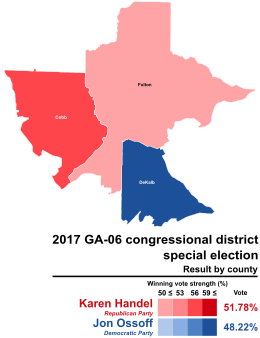| |||||||||||||||||
Georgia's 6th congressional district | |||||||||||||||||
|---|---|---|---|---|---|---|---|---|---|---|---|---|---|---|---|---|---|
| Turnout | 58.16% | ||||||||||||||||
| |||||||||||||||||
 | |||||||||||||||||
| |||||||||||||||||
| Elections in Georgia |
|---|
 |
A special election to determine the member of the United States House of Representatives for Georgia's 6th congressional district was held on April 18, 2017, with a runoff held two months later on June 20. Republican Karen Handel narrowly defeated Democrat Jon Ossoff in the runoff vote, 51.8% to 48.2%. Handel succeeded Tom Price, who resigned from the seat following his confirmation as United States Secretary of Health and Human Services in the Trump administration. The runoff election was necessary when no individual candidate earned the majority of votes in the election on April 18. Ossoff received 48.1% of the vote in the first round, followed by Handel with 19.8%.
Georgia's state law requires the governor of Georgia to call for a special election to be held at least 30 days after a vacancy. Following Price's resignation, Governor Nathan Deal called for the special election to be held on April 18,[1] with a filing window for prospective candidates from February 13 to 15, 2017.[2] All candidates ran on one ballot, with a runoff election scheduled for the first- and second-place finishers, if no candidate received 50% of the vote.[3] Neither Ossoff nor Handel received a majority, and despite Ossoff finishing nearly 30 points ahead in the first round, Handel nonetheless prevailed in the runoff election, though she would ultimately lose reelection in 2018 to Democrat Lucy McBath. Ossoff would later go on to be elected a United States senator, defeating incumbent David Perdue in the 2021 runoff election.
The election attracted exceptional national interest, with both major parties perceiving it as an opportunity to shape the political narrative prior to the 2018 midterm elections.[4][5] The district has a history of favoring GOP House candidates by large margins, but Trump won it by just 1% in 2016, making Democrats hopeful to win a normally strong GOP district. A total of $50 million was spent as of the close of early-voting period on June 17, making it the most expensive House election in history.[6] Of that, more than $40 million was spent on television and radio advertising alone, smashing past House election records.[7] A very high number of voters—140,000—cast ballots during the runoff-election early-voting period.[6]
- ^ Bolton, Ben (February 10, 2017). "Gov. Deal calls for special election following Price confirmation". Fox 5 Atlanta. Archived from the original on February 11, 2017. Retrieved February 10, 2017.
- ^ "Deal congratulates Price, calls special election | Governor Nathan Deal Office of the Governor". Gov.georgia.gov. February 10, 2017. Archived from the original on March 5, 2017. Retrieved March 28, 2017.
- ^ "Here are the candidates eyeing Tom Price's House seat". Atlanta Journal-Constitution. November 29, 2016. Archived from the original on December 2, 2016. Retrieved December 1, 2016.
- ^ Barrow, Bill (February 14, 2017). "Georgia special election shapes up as referendum on Trump". Associated Press.
- ^ Cillizza, Chris (May 9, 2017). "The Georgia special election is now the most expensive House race ever". CNN. Retrieved June 2, 2017.
- ^ a b Bland, Scott (June 17, 2017). "Early-vote turnout soars in Georgia special election". Politico.
- ^ Dann, Carrie (June 12, 2017). "Ad Spending in Georgia Special Election Approaches $40 Million Mark". NBC News.


